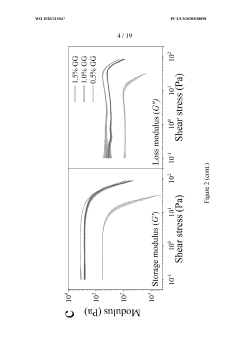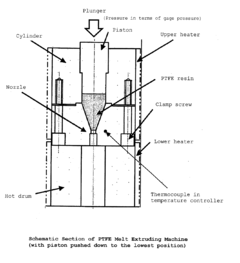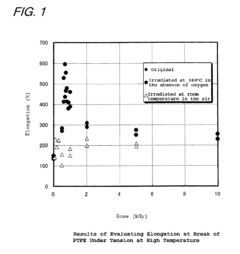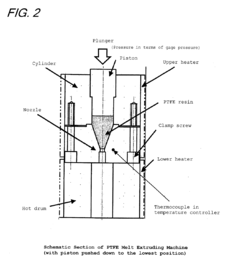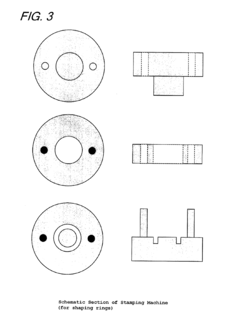PTFE: Transforming the Face of Modern Engineering
JUN 27, 20259 MIN READ
Generate Your Research Report Instantly with AI Agent
Patsnap Eureka helps you evaluate technical feasibility & market potential.
PTFE Evolution and Objectives
Polytetrafluoroethylene (PTFE), commonly known as Teflon, has revolutionized modern engineering since its accidental discovery in 1938 by Roy Plunkett at DuPont. This synthetic fluoropolymer has evolved from a niche material to a ubiquitous presence in various industries due to its exceptional properties. The evolution of PTFE technology has been driven by the continuous pursuit of enhancing its performance characteristics and expanding its applications.
Initially, PTFE was primarily used in military and aerospace applications due to its high heat resistance and chemical inertness. As manufacturing processes improved, PTFE found its way into consumer products, most notably non-stick cookware in the 1960s. This marked a significant milestone in its commercialization and public recognition. The subsequent decades saw PTFE's properties being fine-tuned to meet specific industrial needs, leading to the development of various grades and forms of the material.
The objectives of PTFE research and development have consistently focused on overcoming its inherent limitations while capitalizing on its strengths. Key areas of improvement have included enhancing its mechanical properties, particularly its wear resistance and load-bearing capacity. Researchers have also aimed to develop more efficient production methods to reduce costs and environmental impact, as traditional PTFE manufacturing processes can be energy-intensive and produce harmful byproducts.
Another critical objective has been to expand PTFE's functionality through modifications and composites. This has led to the creation of PTFE-based materials with improved electrical conductivity, thermal management capabilities, and even biocompatibility for medical applications. The development of microporous PTFE membranes has opened up new avenues in filtration and breathable fabrics, further diversifying its application portfolio.
In recent years, the focus has shifted towards sustainability and environmental considerations. Efforts are being made to develop eco-friendly production methods, improve recyclability, and find alternatives to the perfluorooctanoic acid (PFOA) historically used in PTFE production. The industry is also exploring bio-based precursors for PTFE synthesis, aligning with global trends towards greener technologies.
Looking ahead, the evolution of PTFE technology is expected to continue along several trajectories. These include the development of nano-engineered PTFE structures for enhanced performance, the integration of PTFE in advanced composite materials for aerospace and automotive industries, and the exploration of PTFE's potential in emerging fields such as flexible electronics and energy storage. The overarching goal remains to harness PTFE's unique properties while addressing the challenges of sustainability and cost-effectiveness in its production and application.
Initially, PTFE was primarily used in military and aerospace applications due to its high heat resistance and chemical inertness. As manufacturing processes improved, PTFE found its way into consumer products, most notably non-stick cookware in the 1960s. This marked a significant milestone in its commercialization and public recognition. The subsequent decades saw PTFE's properties being fine-tuned to meet specific industrial needs, leading to the development of various grades and forms of the material.
The objectives of PTFE research and development have consistently focused on overcoming its inherent limitations while capitalizing on its strengths. Key areas of improvement have included enhancing its mechanical properties, particularly its wear resistance and load-bearing capacity. Researchers have also aimed to develop more efficient production methods to reduce costs and environmental impact, as traditional PTFE manufacturing processes can be energy-intensive and produce harmful byproducts.
Another critical objective has been to expand PTFE's functionality through modifications and composites. This has led to the creation of PTFE-based materials with improved electrical conductivity, thermal management capabilities, and even biocompatibility for medical applications. The development of microporous PTFE membranes has opened up new avenues in filtration and breathable fabrics, further diversifying its application portfolio.
In recent years, the focus has shifted towards sustainability and environmental considerations. Efforts are being made to develop eco-friendly production methods, improve recyclability, and find alternatives to the perfluorooctanoic acid (PFOA) historically used in PTFE production. The industry is also exploring bio-based precursors for PTFE synthesis, aligning with global trends towards greener technologies.
Looking ahead, the evolution of PTFE technology is expected to continue along several trajectories. These include the development of nano-engineered PTFE structures for enhanced performance, the integration of PTFE in advanced composite materials for aerospace and automotive industries, and the exploration of PTFE's potential in emerging fields such as flexible electronics and energy storage. The overarching goal remains to harness PTFE's unique properties while addressing the challenges of sustainability and cost-effectiveness in its production and application.
PTFE Market Demand Analysis
The global PTFE (Polytetrafluoroethylene) market has experienced significant growth in recent years, driven by its unique properties and versatile applications across various industries. PTFE's exceptional chemical resistance, low friction coefficient, and high-temperature stability have made it an indispensable material in modern engineering and manufacturing processes.
In the automotive sector, PTFE is increasingly used in gaskets, seals, and bearings, contributing to improved fuel efficiency and reduced emissions. The aerospace industry relies heavily on PTFE for its lightweight and heat-resistant properties, utilizing it in aircraft components and space exploration equipment.
The electronics industry has seen a surge in PTFE demand, particularly in the production of high-frequency circuit boards and cable insulation. As 5G technology continues to roll out globally, the need for PTFE in telecommunications infrastructure is expected to grow substantially.
The medical field has also embraced PTFE, with applications ranging from surgical implants to drug delivery systems. Its biocompatibility and non-stick properties make it ideal for use in medical devices and equipment, driving further market expansion.
In the industrial sector, PTFE coatings are widely used to enhance the performance and longevity of machinery and equipment. The chemical processing industry relies on PTFE-lined pipes and vessels to handle corrosive substances safely and efficiently.
The construction industry has found innovative uses for PTFE in architectural membranes and coatings, providing durable and weather-resistant solutions for modern building designs.
As environmental concerns grow, PTFE's role in renewable energy technologies, such as solar panels and fuel cells, is becoming increasingly important. Its ability to withstand harsh conditions and maintain performance over time makes it a valuable material in these applications.
The Asia-Pacific region, particularly China and India, is expected to be the fastest-growing market for PTFE, driven by rapid industrialization and infrastructure development. North America and Europe continue to be significant consumers, with a focus on high-performance applications in aerospace and healthcare.
Despite its many advantages, the PTFE market faces challenges related to environmental concerns and regulatory pressures. The industry is responding by developing more sustainable production methods and exploring recycling technologies to address these issues and ensure long-term market growth.
In the automotive sector, PTFE is increasingly used in gaskets, seals, and bearings, contributing to improved fuel efficiency and reduced emissions. The aerospace industry relies heavily on PTFE for its lightweight and heat-resistant properties, utilizing it in aircraft components and space exploration equipment.
The electronics industry has seen a surge in PTFE demand, particularly in the production of high-frequency circuit boards and cable insulation. As 5G technology continues to roll out globally, the need for PTFE in telecommunications infrastructure is expected to grow substantially.
The medical field has also embraced PTFE, with applications ranging from surgical implants to drug delivery systems. Its biocompatibility and non-stick properties make it ideal for use in medical devices and equipment, driving further market expansion.
In the industrial sector, PTFE coatings are widely used to enhance the performance and longevity of machinery and equipment. The chemical processing industry relies on PTFE-lined pipes and vessels to handle corrosive substances safely and efficiently.
The construction industry has found innovative uses for PTFE in architectural membranes and coatings, providing durable and weather-resistant solutions for modern building designs.
As environmental concerns grow, PTFE's role in renewable energy technologies, such as solar panels and fuel cells, is becoming increasingly important. Its ability to withstand harsh conditions and maintain performance over time makes it a valuable material in these applications.
The Asia-Pacific region, particularly China and India, is expected to be the fastest-growing market for PTFE, driven by rapid industrialization and infrastructure development. North America and Europe continue to be significant consumers, with a focus on high-performance applications in aerospace and healthcare.
Despite its many advantages, the PTFE market faces challenges related to environmental concerns and regulatory pressures. The industry is responding by developing more sustainable production methods and exploring recycling technologies to address these issues and ensure long-term market growth.
PTFE Technical Challenges
Despite its remarkable properties, Polytetrafluoroethylene (PTFE) faces several technical challenges that hinder its wider application and limit its potential in modern engineering. One of the primary issues is the difficulty in processing PTFE due to its high melting point and viscosity. This makes conventional thermoplastic processing techniques ineffective, requiring specialized methods such as sintering or ram extrusion, which are often costly and time-consuming.
Another significant challenge lies in PTFE's poor adhesion properties. While its non-stick nature is beneficial in many applications, it poses problems when bonding PTFE to other materials is necessary. This limitation restricts its use in composite structures and multi-material assemblies, which are increasingly important in advanced engineering applications.
The mechanical properties of PTFE, particularly its creep resistance and wear resistance, present additional challenges. Under sustained load, PTFE tends to deform permanently, limiting its use in long-term load-bearing applications. Moreover, its relatively low wear resistance compared to other engineering plastics can lead to premature failure in high-friction environments.
PTFE's electrical properties, while generally advantageous, can also be problematic in certain scenarios. Its excellent insulating characteristics can lead to static charge buildup, which may be detrimental in applications where electrostatic discharge is a concern, such as in electronic manufacturing or explosive environments.
The environmental impact of PTFE production and disposal is another area of technical challenge. The manufacturing process involves the use of perfluorooctanoic acid (PFOA), a persistent organic pollutant. While efforts have been made to phase out PFOA, finding equally effective and environmentally friendly alternatives remains a challenge.
Recycling PTFE presents its own set of difficulties. The material's high thermal stability means it doesn't melt like other thermoplastics, making traditional recycling methods ineffective. Developing efficient recycling techniques for PTFE is crucial for improving its sustainability profile and reducing its environmental footprint.
Lastly, the high cost of PTFE compared to other polymers limits its adoption in cost-sensitive applications. While its unique properties justify the price in many high-performance scenarios, finding ways to reduce production costs without compromising quality remains a significant challenge for researchers and manufacturers in the field.
Another significant challenge lies in PTFE's poor adhesion properties. While its non-stick nature is beneficial in many applications, it poses problems when bonding PTFE to other materials is necessary. This limitation restricts its use in composite structures and multi-material assemblies, which are increasingly important in advanced engineering applications.
The mechanical properties of PTFE, particularly its creep resistance and wear resistance, present additional challenges. Under sustained load, PTFE tends to deform permanently, limiting its use in long-term load-bearing applications. Moreover, its relatively low wear resistance compared to other engineering plastics can lead to premature failure in high-friction environments.
PTFE's electrical properties, while generally advantageous, can also be problematic in certain scenarios. Its excellent insulating characteristics can lead to static charge buildup, which may be detrimental in applications where electrostatic discharge is a concern, such as in electronic manufacturing or explosive environments.
The environmental impact of PTFE production and disposal is another area of technical challenge. The manufacturing process involves the use of perfluorooctanoic acid (PFOA), a persistent organic pollutant. While efforts have been made to phase out PFOA, finding equally effective and environmentally friendly alternatives remains a challenge.
Recycling PTFE presents its own set of difficulties. The material's high thermal stability means it doesn't melt like other thermoplastics, making traditional recycling methods ineffective. Developing efficient recycling techniques for PTFE is crucial for improving its sustainability profile and reducing its environmental footprint.
Lastly, the high cost of PTFE compared to other polymers limits its adoption in cost-sensitive applications. While its unique properties justify the price in many high-performance scenarios, finding ways to reduce production costs without compromising quality remains a significant challenge for researchers and manufacturers in the field.
Current PTFE Applications
01 PTFE manufacturing processes
Various methods for producing PTFE are described, including polymerization techniques, extrusion processes, and molding methods. These processes aim to improve the quality, efficiency, and properties of the resulting PTFE materials.- PTFE manufacturing and processing methods: Various techniques for manufacturing and processing PTFE are described, including methods for producing PTFE fibers, films, and other forms. These processes often involve specific temperature and pressure conditions, as well as the use of specialized equipment to achieve desired properties in the final product.
- PTFE composites and blends: PTFE is often combined with other materials to create composites or blends with enhanced properties. These combinations can improve characteristics such as wear resistance, thermal conductivity, or mechanical strength. The resulting materials find applications in various industries, including automotive, aerospace, and electronics.
- Surface modification of PTFE: Techniques for modifying the surface of PTFE are explored to enhance its properties or compatibility with other materials. These modifications can include chemical treatments, plasma treatments, or the application of coatings to improve adhesion, wettability, or other surface characteristics.
- PTFE in membrane and filtration applications: PTFE is widely used in membrane and filtration technologies due to its chemical resistance and non-stick properties. Applications include water treatment, gas separation, and industrial filtration. Research focuses on improving membrane performance, durability, and efficiency.
- PTFE in medical and biomedical applications: The use of PTFE in medical and biomedical fields is explored, including applications in implants, surgical materials, and drug delivery systems. Research focuses on improving biocompatibility, reducing complications, and developing new PTFE-based materials for specific medical needs.
02 PTFE composite materials
The development of PTFE-based composite materials is explored, combining PTFE with other substances to enhance its properties or create new functionalities. These composites may include fillers, reinforcing agents, or other polymers to improve mechanical, thermal, or electrical characteristics.Expand Specific Solutions03 Surface modification of PTFE
Techniques for modifying the surface properties of PTFE are discussed, including chemical treatments, plasma treatments, and coating methods. These modifications aim to improve adhesion, wettability, or other surface-dependent properties of PTFE materials.Expand Specific Solutions04 PTFE applications in various industries
The use of PTFE in diverse industrial applications is explored, including its implementation in cookware, textiles, electronics, automotive parts, and medical devices. The material's unique properties, such as low friction and chemical resistance, make it suitable for a wide range of uses.Expand Specific Solutions05 Recycling and environmental considerations of PTFE
Methods for recycling PTFE and addressing environmental concerns related to its production and disposal are discussed. This includes techniques for reprocessing PTFE waste, reducing environmental impact, and developing more sustainable PTFE-based products.Expand Specific Solutions
Key PTFE Industry Players
The PTFE market is in a mature growth stage, characterized by steady demand and established applications across various industries. The global market size for PTFE is substantial, estimated to be in the billions of dollars, with consistent growth projected in the coming years. Technologically, PTFE is well-developed, with ongoing innovations focused on enhancing performance and expanding applications. Key players like DAIKIN INDUSTRIES, DuPont de Nemours, and 3M Innovative Properties are at the forefront of PTFE technology, continuously investing in R&D to maintain their competitive edge. These companies, along with others such as W. L. Gore & Associates and AGC, Inc., are driving advancements in PTFE formulations, processing techniques, and novel applications, particularly in high-performance industries like aerospace, electronics, and medical devices.
DAIKIN INDUSTRIES Ltd.
Technical Solution: Daikin has developed a range of PTFE products under their Polyflon™ brand, including granular PTFE resins, fine powders, and aqueous dispersions. Their research focuses on improving the processing characteristics of PTFE, such as developing grades with improved moldability and sintering properties[10]. Daikin has also made advancements in modified PTFE technologies, creating grades with enhanced mechanical properties and lower deformation under load[11]. Additionally, they have developed PTFE-based composite materials that combine the benefits of PTFE with other polymers or fillers to meet specific application requirements[12].
Strengths: Comprehensive PTFE product line, strong presence in Asian markets, focus on modified PTFE technologies. Weaknesses: Intense competition in the PTFE market, potential environmental concerns related to fluoropolymer production.
AGC, Inc. (Japan)
Technical Solution: AGC has developed a range of PTFE products under their Fluon® brand, including PTFE resins, compounds, and dispersions. Their research focuses on creating high-purity PTFE grades for semiconductor applications and developing PTFE micropowders for use as additives in various industries[13]. AGC has also made advancements in PTFE film technology, producing thin, uniform PTFE films for use in electronics and industrial applications[14]. Additionally, they have developed PTFE-based composite materials that combine PTFE with other polymers or fillers to enhance specific properties such as wear resistance or thermal conductivity[15].
Strengths: Strong presence in Asian markets, focus on high-purity PTFE grades for specialized applications. Weaknesses: Intense competition in the PTFE market, potential regulatory challenges related to fluoropolymer production.
PTFE Innovation Breakthroughs
Fluoropolymer shear-thinning INKS and methods of making and using same
PatentWO2020215047A1
Innovation
- Development of shear-thinning inks comprising PTFE particles, a medium, and a shear-thinning agent like gellan gum, combined with a multistage thermal treatment process for direct ink writing, allowing for the creation of complex PTFE structures with tunable mechanical properties.
Polytetrafluoroethylene resins that can be processed by shaping, shaped products thereof, and processes for producing the resins and shaped products
PatentInactiveUS20110171403A1
Innovation
- Exposing PTFE to an extremely small dose of ionizing radiation at a temperature just above its melting point in the absence of oxygen to create a two-dimensional branched structure, allowing for processing by common shaping techniques and producing unattainable shapes such as extremely small thickness, small diameter, or high draw ratio products.
Environmental Impact of PTFE
Polytetrafluoroethylene (PTFE), commonly known as Teflon, has revolutionized various industries with its unique properties. However, its environmental impact has become a growing concern in recent years. The production, use, and disposal of PTFE have significant implications for ecosystems and human health.
During the manufacturing process of PTFE, perfluorooctanoic acid (PFOA) is often used as a processing aid. PFOA is a persistent organic pollutant that can accumulate in the environment and living organisms. It has been linked to various health issues, including cancer, thyroid disease, and developmental problems. Although many manufacturers have phased out PFOA, its legacy contamination remains a challenge.
The durability of PTFE, while beneficial for many applications, poses a problem for waste management. PTFE products do not biodegrade and can persist in landfills for centuries. When incinerated, PTFE releases toxic fluorine compounds, including hydrogen fluoride and perfluoroisobutylene, which can contribute to air pollution and pose health risks to nearby communities.
Microplastics derived from PTFE products are another environmental concern. As PTFE items wear down, they release microscopic particles that can enter waterways and soil. These microplastics can be ingested by marine life and potentially enter the food chain, impacting ecosystems and human health in ways that are not yet fully understood.
The production of PTFE also contributes to greenhouse gas emissions. The process involves the use of fluorinated gases, which are potent greenhouse gases with high global warming potential. Although emissions have been reduced in recent years due to improved manufacturing techniques and regulations, the carbon footprint of PTFE production remains significant.
On the positive side, PTFE's non-stick and low-friction properties can contribute to energy efficiency in certain applications. For instance, PTFE coatings on industrial equipment can reduce friction, leading to lower energy consumption and extended equipment life. This indirect environmental benefit should be considered when evaluating the overall impact of PTFE.
Efforts to mitigate the environmental impact of PTFE are ongoing. Research into alternative production methods, such as using supercritical carbon dioxide instead of PFOA, shows promise for reducing harmful emissions. Additionally, advancements in recycling technologies for fluoropolymers may help address the end-of-life challenges associated with PTFE products.
As industries continue to rely on PTFE for its unique properties, balancing its benefits with environmental concerns remains a critical challenge. Future developments in green chemistry and sustainable manufacturing practices will be crucial in minimizing the ecological footprint of this versatile material while maintaining its technological advantages.
During the manufacturing process of PTFE, perfluorooctanoic acid (PFOA) is often used as a processing aid. PFOA is a persistent organic pollutant that can accumulate in the environment and living organisms. It has been linked to various health issues, including cancer, thyroid disease, and developmental problems. Although many manufacturers have phased out PFOA, its legacy contamination remains a challenge.
The durability of PTFE, while beneficial for many applications, poses a problem for waste management. PTFE products do not biodegrade and can persist in landfills for centuries. When incinerated, PTFE releases toxic fluorine compounds, including hydrogen fluoride and perfluoroisobutylene, which can contribute to air pollution and pose health risks to nearby communities.
Microplastics derived from PTFE products are another environmental concern. As PTFE items wear down, they release microscopic particles that can enter waterways and soil. These microplastics can be ingested by marine life and potentially enter the food chain, impacting ecosystems and human health in ways that are not yet fully understood.
The production of PTFE also contributes to greenhouse gas emissions. The process involves the use of fluorinated gases, which are potent greenhouse gases with high global warming potential. Although emissions have been reduced in recent years due to improved manufacturing techniques and regulations, the carbon footprint of PTFE production remains significant.
On the positive side, PTFE's non-stick and low-friction properties can contribute to energy efficiency in certain applications. For instance, PTFE coatings on industrial equipment can reduce friction, leading to lower energy consumption and extended equipment life. This indirect environmental benefit should be considered when evaluating the overall impact of PTFE.
Efforts to mitigate the environmental impact of PTFE are ongoing. Research into alternative production methods, such as using supercritical carbon dioxide instead of PFOA, shows promise for reducing harmful emissions. Additionally, advancements in recycling technologies for fluoropolymers may help address the end-of-life challenges associated with PTFE products.
As industries continue to rely on PTFE for its unique properties, balancing its benefits with environmental concerns remains a critical challenge. Future developments in green chemistry and sustainable manufacturing practices will be crucial in minimizing the ecological footprint of this versatile material while maintaining its technological advantages.
PTFE Regulatory Framework
The regulatory framework surrounding PTFE (Polytetrafluoroethylene) plays a crucial role in shaping its applications and market dynamics. As a widely used synthetic fluoropolymer, PTFE is subject to various regulations and standards across different industries and regions.
In the United States, the Food and Drug Administration (FDA) regulates PTFE's use in food contact applications. The FDA has approved PTFE for use in food processing equipment and cookware, recognizing its non-stick properties and chemical inertness. However, manufacturers must adhere to specific guidelines regarding the composition and processing of PTFE to ensure its safety for food-related applications.
The Environmental Protection Agency (EPA) also oversees PTFE production and use, particularly concerning potential environmental impacts. The EPA has implemented regulations to control the release of perfluorooctanoic acid (PFOA), a chemical previously used in PTFE manufacturing. These regulations have led to the development of alternative production methods and the phasing out of PFOA in the PTFE industry.
In the European Union, PTFE falls under the purview of the Registration, Evaluation, Authorization, and Restriction of Chemicals (REACH) regulation. REACH requires manufacturers and importers to register PTFE and provide safety information, ensuring its responsible use and minimizing potential risks to human health and the environment.
The medical device industry heavily relies on PTFE for various applications, and regulatory bodies such as the FDA and the European Medicines Agency (EMA) have established stringent guidelines for its use in medical implants and devices. These regulations focus on biocompatibility, sterilization processes, and long-term safety of PTFE-based medical products.
In the aerospace sector, organizations like the Federal Aviation Administration (FAA) and the European Aviation Safety Agency (EASA) have set standards for PTFE's use in aircraft components. These regulations address factors such as fire resistance, durability, and performance under extreme conditions.
As environmental concerns grow, regulatory bodies are increasingly focusing on the end-of-life management of PTFE products. Initiatives promoting recycling and proper disposal of PTFE-containing materials are being developed to address sustainability challenges associated with this durable polymer.
The global nature of PTFE production and trade necessitates harmonization of regulatory frameworks across different regions. International standards organizations, such as the International Organization for Standardization (ISO), play a vital role in establishing consistent quality and safety standards for PTFE products worldwide.
In the United States, the Food and Drug Administration (FDA) regulates PTFE's use in food contact applications. The FDA has approved PTFE for use in food processing equipment and cookware, recognizing its non-stick properties and chemical inertness. However, manufacturers must adhere to specific guidelines regarding the composition and processing of PTFE to ensure its safety for food-related applications.
The Environmental Protection Agency (EPA) also oversees PTFE production and use, particularly concerning potential environmental impacts. The EPA has implemented regulations to control the release of perfluorooctanoic acid (PFOA), a chemical previously used in PTFE manufacturing. These regulations have led to the development of alternative production methods and the phasing out of PFOA in the PTFE industry.
In the European Union, PTFE falls under the purview of the Registration, Evaluation, Authorization, and Restriction of Chemicals (REACH) regulation. REACH requires manufacturers and importers to register PTFE and provide safety information, ensuring its responsible use and minimizing potential risks to human health and the environment.
The medical device industry heavily relies on PTFE for various applications, and regulatory bodies such as the FDA and the European Medicines Agency (EMA) have established stringent guidelines for its use in medical implants and devices. These regulations focus on biocompatibility, sterilization processes, and long-term safety of PTFE-based medical products.
In the aerospace sector, organizations like the Federal Aviation Administration (FAA) and the European Aviation Safety Agency (EASA) have set standards for PTFE's use in aircraft components. These regulations address factors such as fire resistance, durability, and performance under extreme conditions.
As environmental concerns grow, regulatory bodies are increasingly focusing on the end-of-life management of PTFE products. Initiatives promoting recycling and proper disposal of PTFE-containing materials are being developed to address sustainability challenges associated with this durable polymer.
The global nature of PTFE production and trade necessitates harmonization of regulatory frameworks across different regions. International standards organizations, such as the International Organization for Standardization (ISO), play a vital role in establishing consistent quality and safety standards for PTFE products worldwide.
Unlock deeper insights with Patsnap Eureka Quick Research — get a full tech report to explore trends and direct your research. Try now!
Generate Your Research Report Instantly with AI Agent
Supercharge your innovation with Patsnap Eureka AI Agent Platform!



